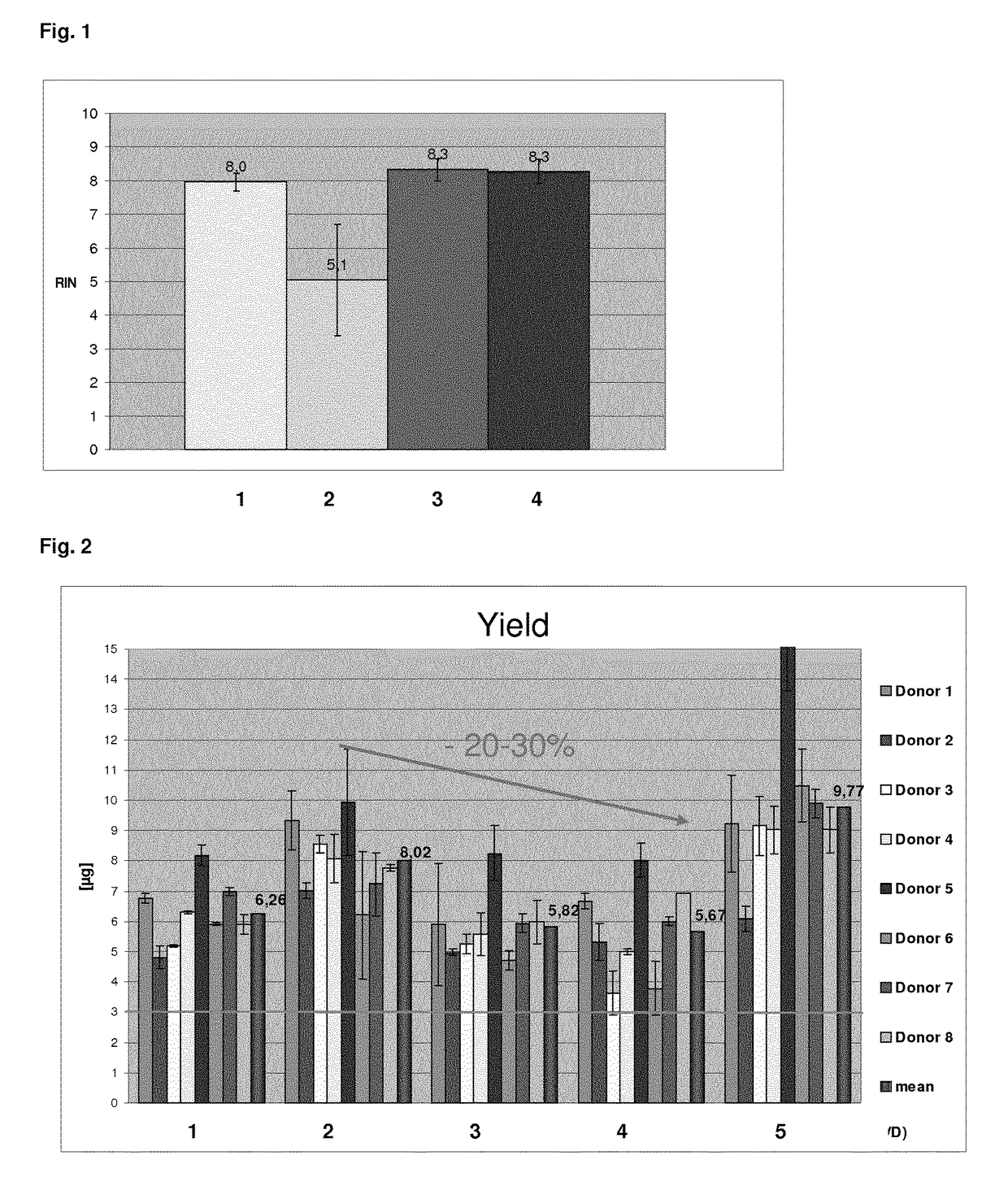Method for isolating nucleic acids
a nucleic acid and isolating technology, applied in the field of isolating nucleic acids, can solve the problems of reducing the yield of nucleic acids, and achieve the effect of reducing the variability of nucleic acid yield and quality, and more flexibility
- Summary
- Abstract
- Description
- Claims
- Application Information
AI Technical Summary
Benefits of technology
Problems solved by technology
Method used
Image
Examples
example 1
[0152]24 blood samples (2.5 ml) were collected per batch in PAXgene Blood RNA Tubes (which comprise a cationic detergent as stabilising agent). The samples were stabilized for 24 h at room temperature and were processed with the QIAsymphony PAXgene Blood RNA Kit, 2008 (QIAGEN) according to the manufacturer's instructions.
QIAsymphony PAXgene Blood RNA Kit
[0153]In the QIAsymphony PAXgene Blood RNA protocol (prior art), the stabilised samples are manually prepared in order to collect and resuspend the pellet which comprises the complexes comprising the cationic detergent and the nucleic acids. Said pellet is obtained by centrifugation and the supernatant is decanted. Afterwards, 300 μl of the resuspension buffer BR1 (QIAGEN) was added to the pellet and vortexed. The respectively manually prepared samples were then loaded on the QIAsymphony robotic system and the nucleic acids were isolated from the resuspended samples according to the QIAsymphony script.
[0154]The first batch was direct...
example 2
[0164]In Example 2, the QIAsymphony PAXgene Blood RNA protocol described above and a modified version (wherein a chaotropic agent is added during resuspension) was analysed with respect to the nucleic acid yield. In said modified version 3 that was tested in Example 2, the nucleic acid isolation was also performed on the QIAsymphony according to the QIAsymphony PAXgene Blood RNA protocol, however, using a modified binding buffer in order to improve nucleic acid binding, in particular the binding of small RNA. The modified binding buffer that was used in Example 2 instead of the binding buffer QSB1 that is used in the QIAsymphony PAXgene Blood RNA protocol, comprised more than 60% isopropanol and 0.2M sodium trichloroacetate. Respectively modified binding buffers to achieve improved binding in particular of small nucleic acids and corresponding nucleic acid isolation protocols are described in EP 10 000 432.4, herein incorporated by reference. The resuspension of the sample was perfo...
example 3
[0172]In order to ensure both, a high RNA integrity and a high nucleic acid yield, the protocol was modified according to the teachings of the present invention. Thus, the pellet was resuspended by adding a modified resuspension buffer, which additionally comprised EDTA. For this purpose, 25 mM EDTA was added to the resuspension buffer BR1 (QIAGEN) that is used for resuspension in the prior art protocol. 280 μl of this modified resuspension buffer BR1 was added to the pellet that was obtained from the PAXgene stabilised blood samples (see Example 1). Furthermore, for resuspension 20 μl proteinase K was added per sample. The sample was resuspended by vortexing and 200 μl of a buffer comprising a chaotropic agent (BR2, QIAGEN—comprises >3M GITC) was added.
[0173]The resuspended samples were loaded on the QIAsymphony robotic system and the automated nucleic acid extraction was performed. In brief, the nucleic acid isolation protocol comprised the following steps:
1. Sample Digestion
[0174...
PUM
| Property | Measurement | Unit |
|---|---|---|
| volumes | aaaaa | aaaaa |
| concentration | aaaaa | aaaaa |
| temperature | aaaaa | aaaaa |
Abstract
Description
Claims
Application Information
 Login to View More
Login to View More - R&D
- Intellectual Property
- Life Sciences
- Materials
- Tech Scout
- Unparalleled Data Quality
- Higher Quality Content
- 60% Fewer Hallucinations
Browse by: Latest US Patents, China's latest patents, Technical Efficacy Thesaurus, Application Domain, Technology Topic, Popular Technical Reports.
© 2025 PatSnap. All rights reserved.Legal|Privacy policy|Modern Slavery Act Transparency Statement|Sitemap|About US| Contact US: help@patsnap.com



